This section will define all the main points of each of the different SDKs available to us, and we will build our first program with them. This will be in a step-by-step and very in-depth tutorial design sort of way, since this is a lot of information to package and condense into a small section without needing to reiterate the information in later chapters.
Building our first AR applications
Setting up Vuforia
It is now time to set up a Unity3D project for each of the different SDKs that will serve as the basis for later chapters when we use each of them to build an application or a game. Let's start with Vuforia, since it is the simplest one to set up:
- We now need to register with Vuforia. Navigate to https://developer.vuforia.com/vui/user/register in order to go to the registration landing page. If you live in a country in which Google is blocked, you should use a VPN, because the registration page uses the Google-powered reCAPTCHA and you can't continue without it:
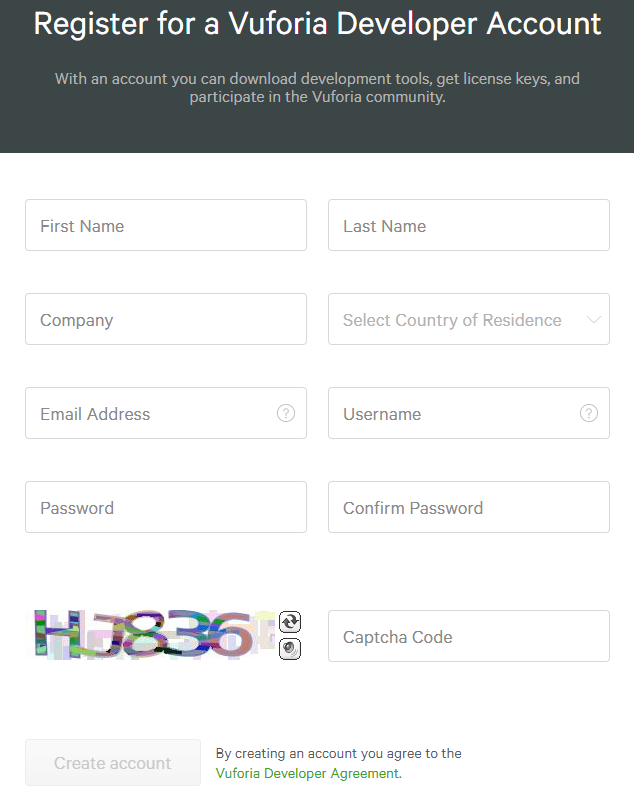
- Once you can log in, navigate to the Develop tab; alternatively, follow this link: https://developer.vuforia.com/targetmanager/licenseManager/licenseListing.
- You will see two main items, License Manager and Target Manager. The License Manager will allow you to create a free Development Key or purchase a Development Key. We want to create a free one. Click on Get Development Key. Enter a name for the app, which you can change at any time. I shall call mine VuforiaIntro:
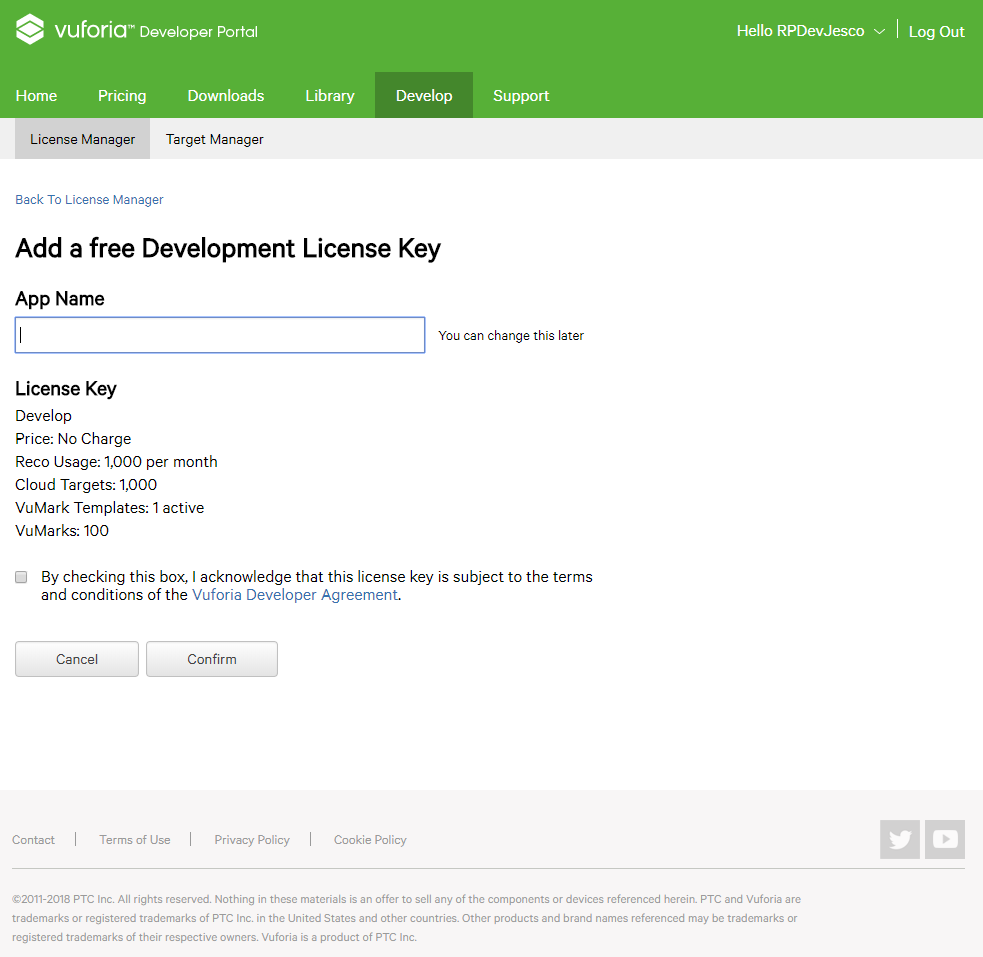
- Now, we have our key with Vuforia. In order to see the license key, we need to click on the name of our app:
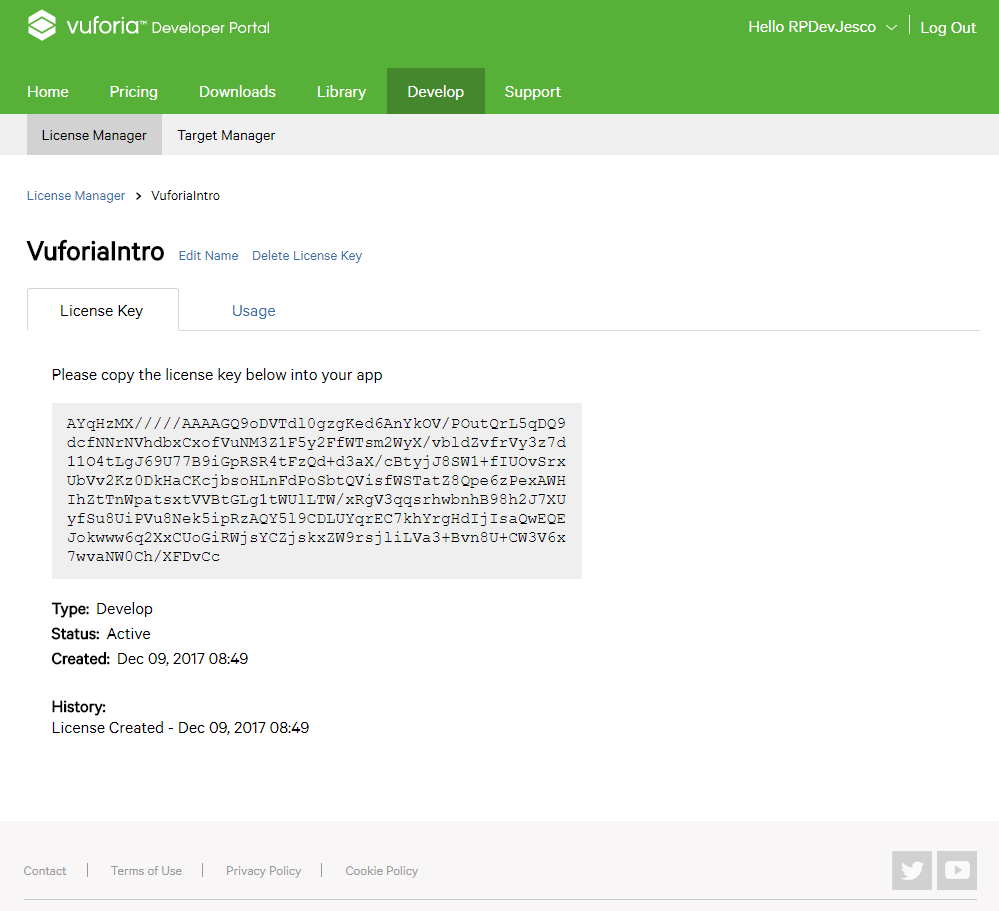
- This next page gives us two very important pieces of information: License Key and Usage details. The Usage details tells us how many Cloud recognitions, Cloud databases, Recognitions used, Cloud targets used, VuMarks generated, VuMark databases, VuMark templates, and VuMarks we have used or currently have remaining:
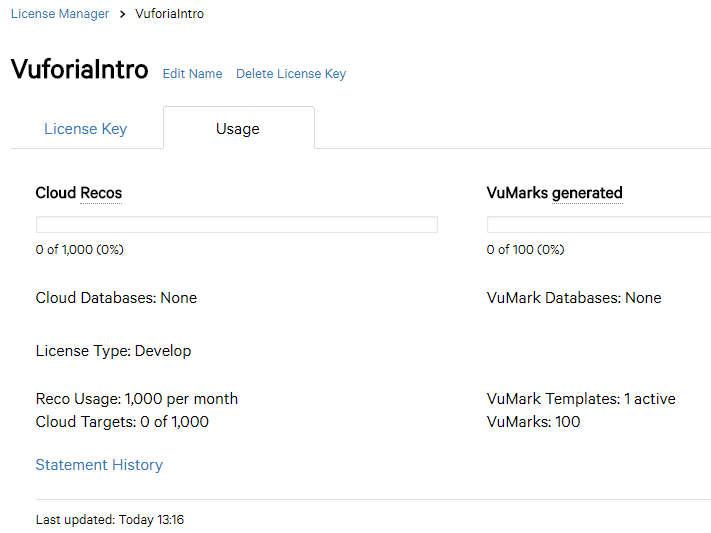
- The License Key details tell us our key (which is easy to copy to the clipboard), the type of key it is, the status of the key, the date it was created, and the history of the key.
Now, we are ready to set up Vuforia and get the demo project working appropriately.
As stated previously, Vuforia is fully integrated into Unity3D as of 2017.2, and is a dream to work with once you learn the basics of the SDK. Vuforia is made to strictly deal with the graphics portion of AR. It can recognize images and objects, and it has the ability to interact with the real world, because it uses computer vision. Since Vuforia is built into Unity3D, we will do the installation of Unity with Vuforia all in one go.
If you don't have Unity3D installed on your computer now, let's go ahead and do that:
- Navigate to http://www.Unity3D.com and download the latest Personal edition (or one of the others, if you are a high roller) installer for Unity:
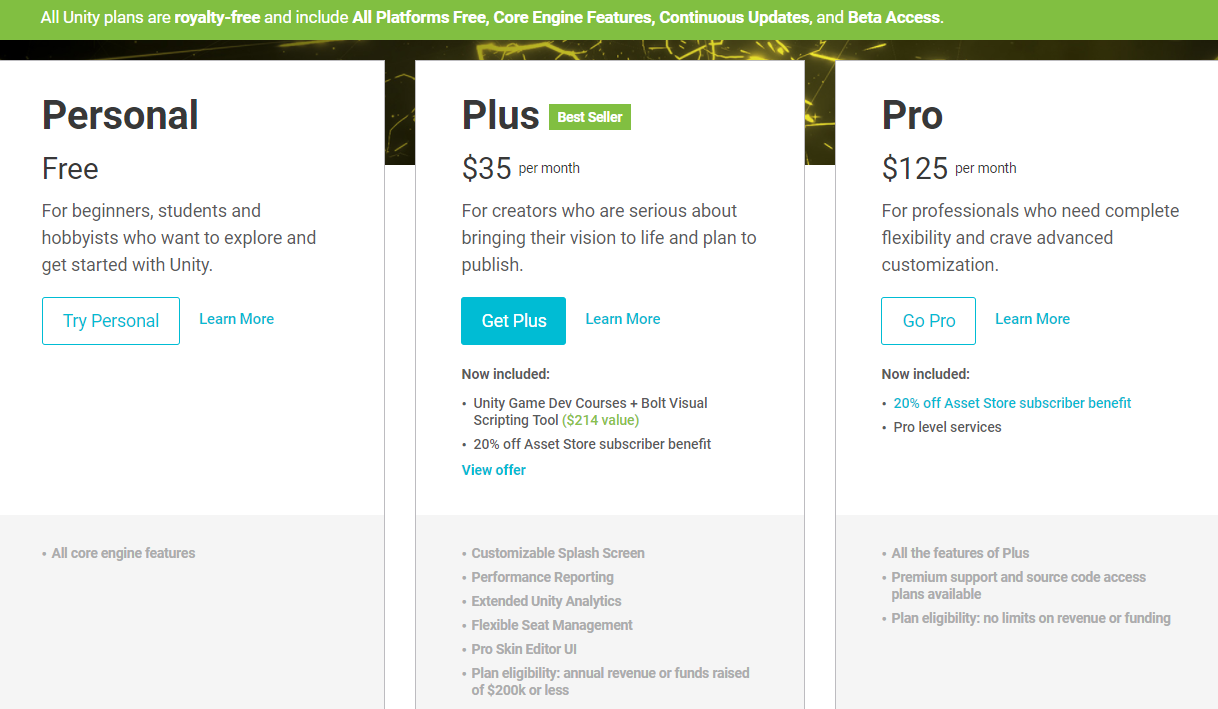
- When you get to the components section of the installer, make sure to select all the platforms you want to support. I typically select Android Build Support, Linux Build Support, SamsungTV Build Support, Tizen Build Support, WebGL Build Support, and UWP (Universal Windows Platform) Build Support. There is one additional one you need to make sure you select, and that is Vuforia Augmented Reality Support:
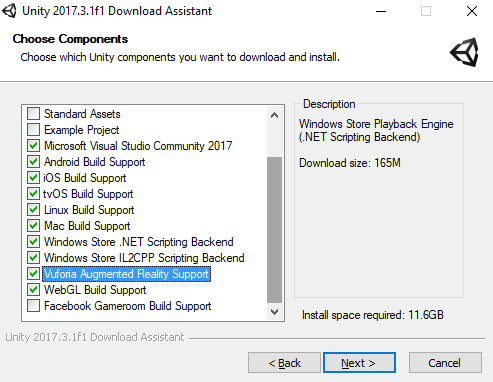
Now that Unity3D has been installed, let's create a brand new Unity project:
- Vuforia recommends that you use a 3D project setup for their AR apps, so, with that in mind, I will keep it as a 3D project with Enable Unity Analytics disabled, and the name of the project shall be VuforiaIntro:
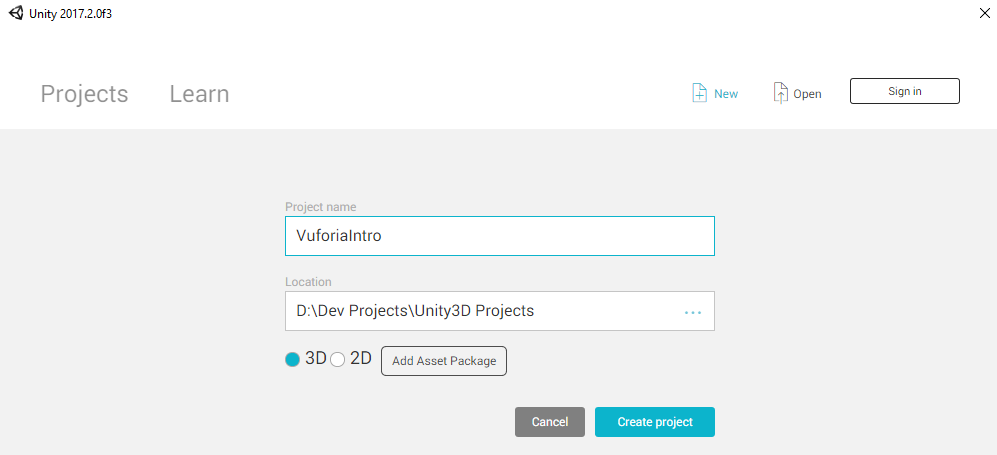
- Once the project has loaded, we can take a look at some of the additional editor items we have access to now. In the toolbar at the top of the Unity Editor, we will see File, Edit, Assets, GameObject, Component, Window, and Help:

- GameObject, Component, Window, and Help have additional items added to them. Looking at GameObject, we can see that the additional item is Vuforia. Inside the Vuforia item, we have AR Camera, Image, Multi Image, Cylindrical Image, Cloud Image, Camera Image, VuMark, and 3D Scan:
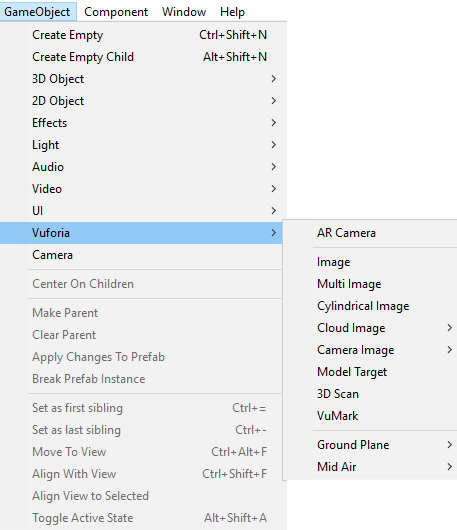
- Cloud Image has some additional items, so let's take a look at that. We have Cloud Provider and Cloud Image Target available to us:
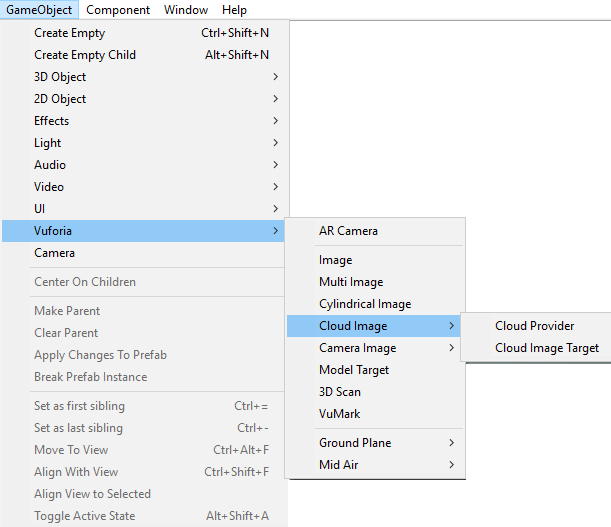
- Camera Image also has some additional items, so we should also be familiar with those options. The options available are Camera Image Builder and Camera Image Target:
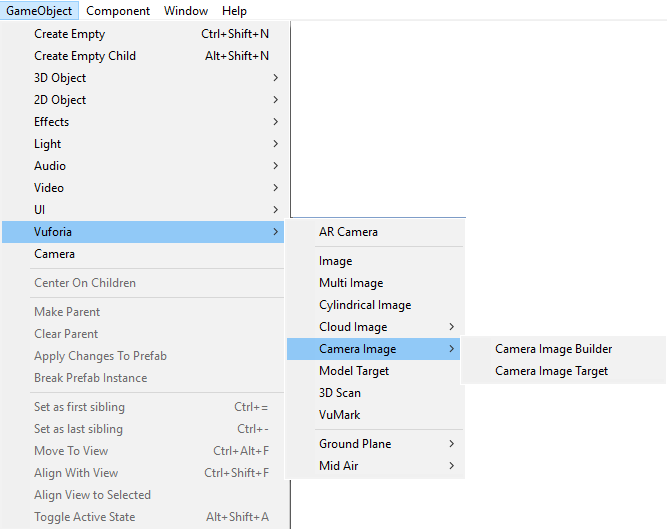
Before we go any further, we should know exactly what these options do and how they look when added to the project prior to the license being applied.
AR Camera replaces the standard camera, as it has the base camera component and Audio Listener components. We also see that it has two scripts attached, Vuforia Behavior and Default Initialization Error Handler:
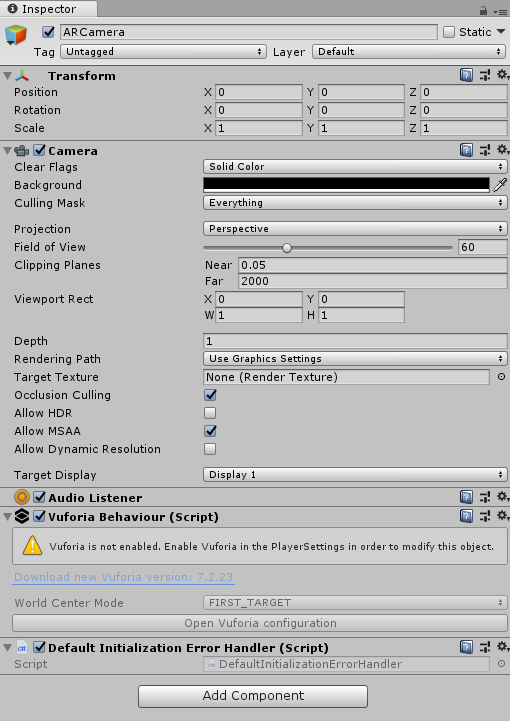
- Image is what allows you to add a trackable object into your AR project and serves as the basis for allowing you to have a mount point for bringing models into the camera feed.
- Multi Image allows you to add multiple trackable objects into your AR project and serves as the anchor for bringing models into the camera feed in real time.
- Cylindrical Image is an anchor for images wrapped onto objects that are cylindrical in shape.
- VuMark is a custom barcode made by the Vuforia team. It allows you to encode data into it as well as act as an AR target like the Image, Multi Image, and Cylindrical Image.
- Cloud Provider is a direct link to your cloud database for specialized AR-designed branding. It is supposed to be used for publications (catalogs, magazines, newspapers, and so on), retailers (product visualization and in-store traffic generation), advertisers (multi-branded content, coupons, and promotions), and product recognition (wine labels/ bottles, cereal boxes, and so on).
- Cloud Image Target is what allows you to add a trackable object into the AR project and serves as the anchor for the app to send the recognized data to the cloud database to retrieve the information and display it as you wish.
- Camera Image Builder is what allows you to define a target image to be stored in a database for retrieval and usage in an AR application.
- Camera Image Target serves as the anchor for which to use the self-defined target image to display what you want on screen when recognized.
The next set of items to talk about is in the Component toolbar. The special components lie within the AR, Scripts, and XR portions of the Component window, as marked in the following screenshot for reference. In order to use them, you have to have a GameObject in the scene and add the component from the toolbar to it. We have World Anchor, Tracked Pose Driver, Spatial Mapping Collider, and Spatial Mapping Renderer available. We should do a deep dive in so that we can know exactly what these items do:
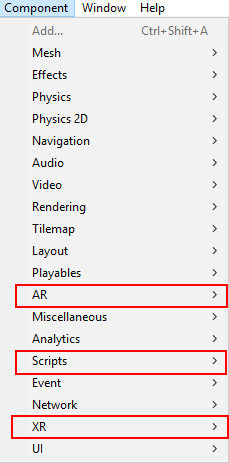
- World Anchor is a component that represents a link between an exact point in the physical world and the parent GameObject of the World Anchor. Once added, a GameObject with a World Anchor component remains locked in place to locations in the real world.
- Tracked Pose Driver is a component that applies the current Pose value of a tracked device to the transform of the Game Object.
- Spatial Mapping Collider allows for holographic content (or character) interaction, such as physics, with the spatial mapping mesh.
- Spatial Mapping Renderer is a component that gives a visual representation of Spatial Mapping surfaces. This is useful for visually debugging surfaces and adding visual effects to the environment.
It should be noted that there are items related to Vuforia in the Scripts section, however, we will not cover those here. But, just for the sake of making sure that the items are listed, they are as follows:
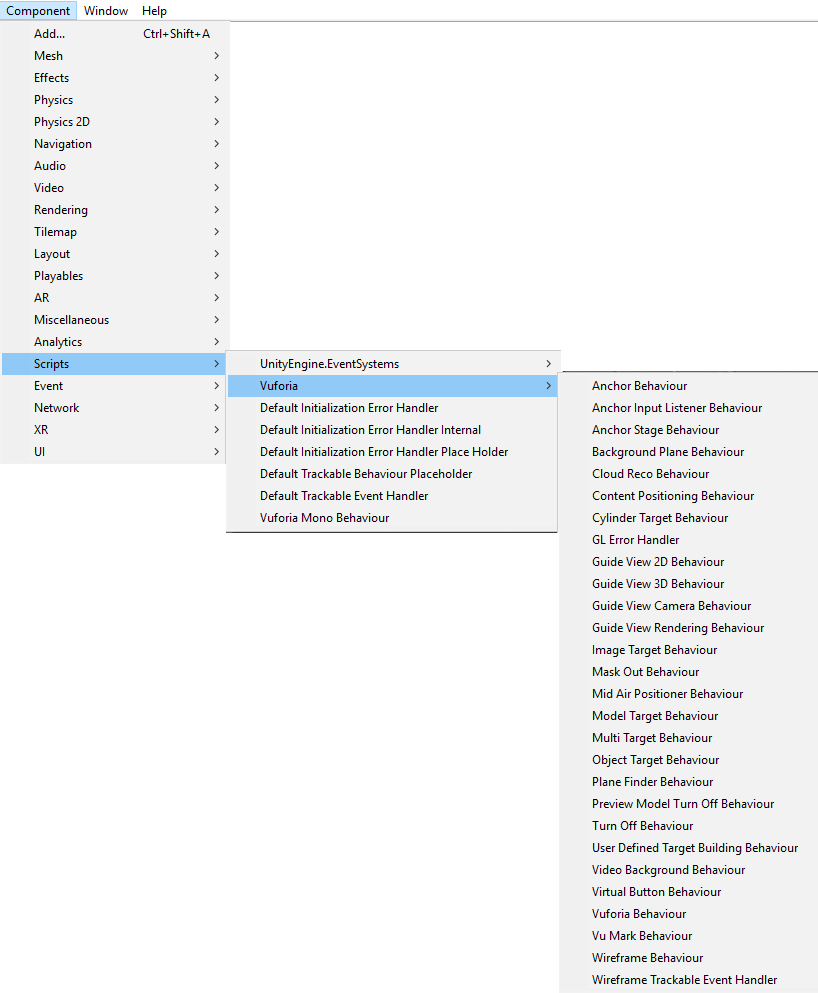
- Background Plane Behaviour
- Cloud Reco Behaviour
- Cylinder Target Behaviour
- GL Error Handler
- Image Target Behaviour
- Mask Out Behaviour
- Multi Target Behaviour
- Object Target Behaviour
- Prop Behaviour
- Reconstruction Behaviour
- Reconstruction From Target Behaviour
- Surface Behaviour
- Text Reco Behaviour
- Turn Off Behaviour
- Turn off Word Behaviour
- User Defined Target Building Behaviour
- Video Background Behaviour
- Virtual Button Behaviour
- Vuforia Behaviour
- Vuforia Deinit Behaviour
- Vu Mark Behaviour
- Wireframe Behaviour
- Wireframe Trackable Event Handler
- Word Behaviour
In the Inspector pane, we have Vuforia Configuration. The following is a screenshot of it; next, we will define what it does:
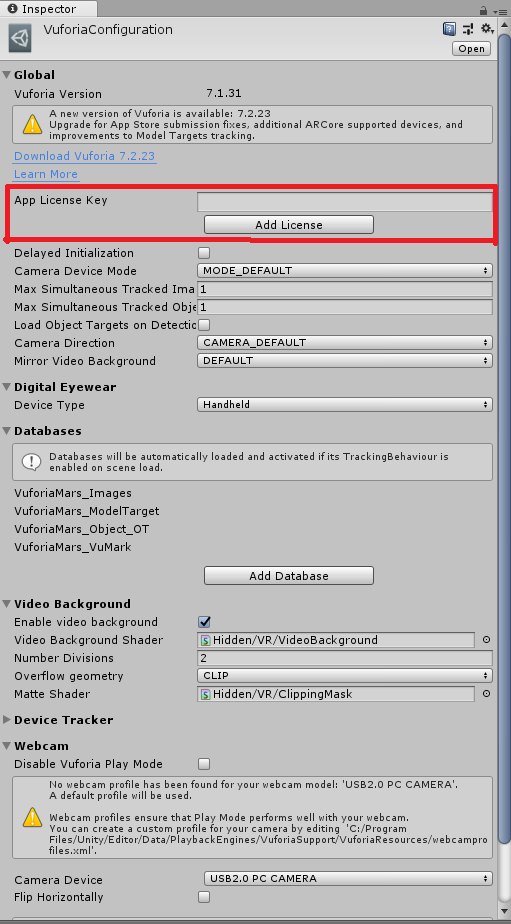
Vuforia Configuration allows you to enter your License Key. Clicking on Add License will load the Vuforia Developer landing page. It also allows you to specify what you want Vuforia to be configured to work for, such as a HUD, smartglasses, a webcam, or a smartphone.
Since we are here, let's go ahead and add our app key to Vuforia (see Vuforia Add License for its location):
- You should create your own app key, since my app key will not be valid by the time of the release of this book. After copying and pasting your key into the license key box, just press the Return/Enter key and you are done:
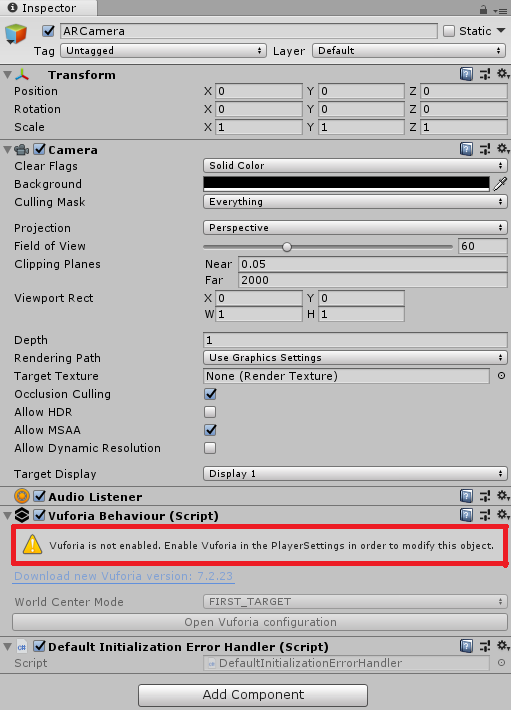
- Since we are testing on PC and if you have a webcam that works for said PC, make sure that the Camera Device selects the proper webcam for usage:
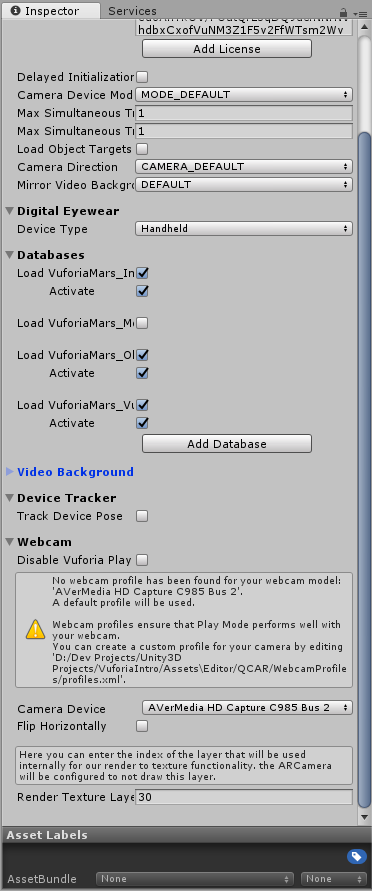
- Next, we need to go into the Unity Player Settings and fix some options. Navigate to File and click on Build Settings. The Build Settings box should appear. Make sure you change the project type to build to Android, and then click on Player Settings:
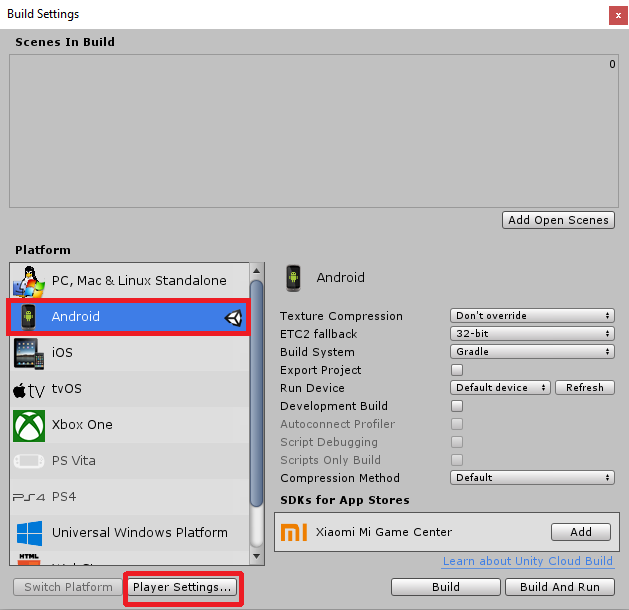
- Vuforia does not support FAT device filter or Android TV, so we need to change those two options. Device Filter, which is located in Other Settings, needs to be changed to ARMv7, and Android TV Compatibility needs to be unchecked.
- Now, we can finally build our "Hello World" AR application for testing to make sure Vuforia and Unity3D are working well together. If you haven't done so already, remove the regular camera component from the Hierarchy Pane and replace it with the ARCamera:

- The next step is to add the Vuforia Image to the scene, which is also known as the ImageTarget:

- We now need to download and add a 3D model to the scene. So, let's go with the easy route and just add a sphere to the scene with the x, y, and z scale set to 0.3. Take extra special care to make sure that the sphere is a child of the ImageTarget. This is very important:
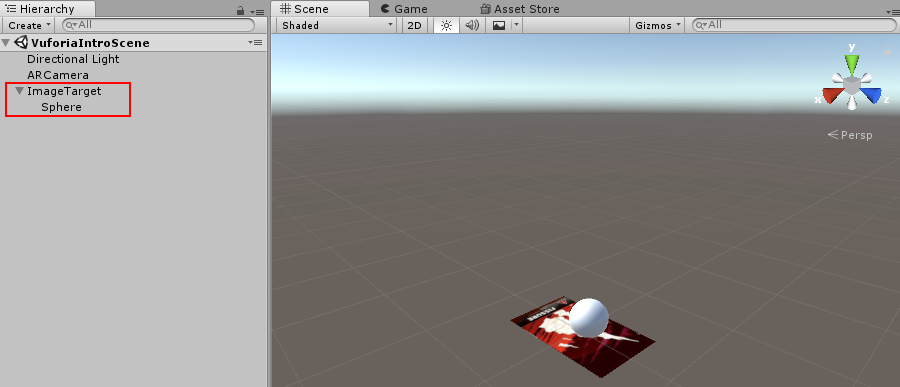
- The next step is to navigate to Editor | Vuforia | ForPrint | ImageTargets, and print out on a piece of paper target_images_A4 or target_images_USLetter:

- Once you have it printed, we can begin the final portion of the test, which is to run the program and hold the printout of the drone in front of the webcam:
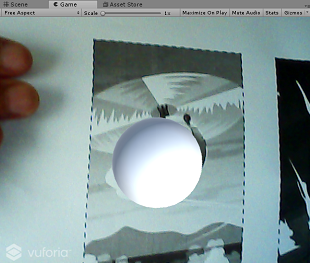
- Vuforia has now been properly configured and tested appropriately, so we can move on to the next SDK to set up and configure.
Setting up ARToolKit
ARToolKit has been depreciated and is now part of the Daqri Vos API. which you can view at https://developer.daqri.com/#!/content/develop
This section has been kept in for incase you want to utilize ARToolkit from the github link https://github.com/artoolkit/arunity5
There are two different ways you can get ARToolKit in a project and ready to develop with. The first option is the easiest, and that is through the Asset Store: https://assetstore.unity.com/packages/tools/artoolkit-6-unitypackage-94863. This is the latest version of ARToolKit in the Asset Store and it will be imported directly into Unity for you. The other option is to go to the main website of ARToolKit: https://github.com/artoolkit/artoolkit5. This allows you to get additional tools and the actual SDK, along with the Unity Package.
For installation into Unity3D, we will go with the second option, since it is less intuitive than the first option:
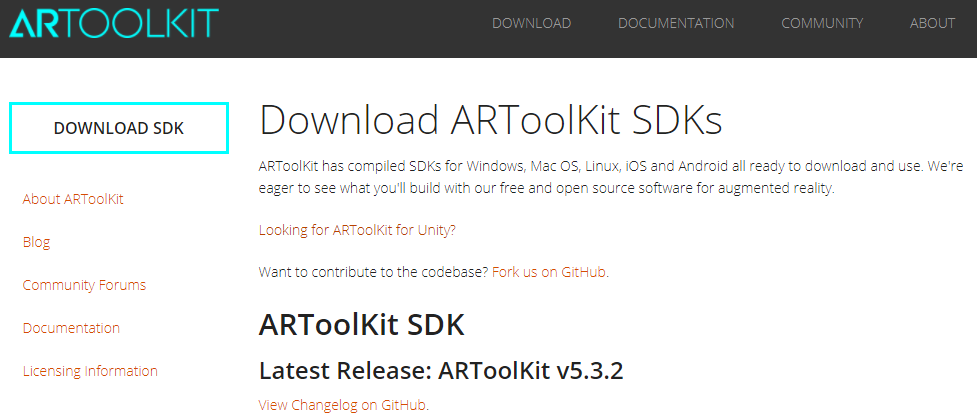
- Navigate to the main website for ARToolKit and click on DOWNLOAD SDK. The macOS, Windows, iOS, Android, Linux, Windows 8.1, and Source Dependencies don't need to be downloaded, but they can be if you want to go deeper into how ARToolKit works under the hood or if you want to use it in a non-Unity capacity. Instead, head toward the bottom of the page and click on the DOWNLOAD UNITY PACKAGE button:
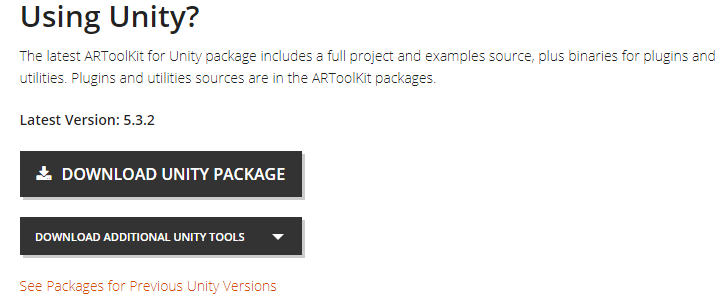
- Now that the package has been downloaded, we need to open Unity3D and create a new project. I will call mine ARToolKitIntro. Keep the settings as default for simplicity's sake:
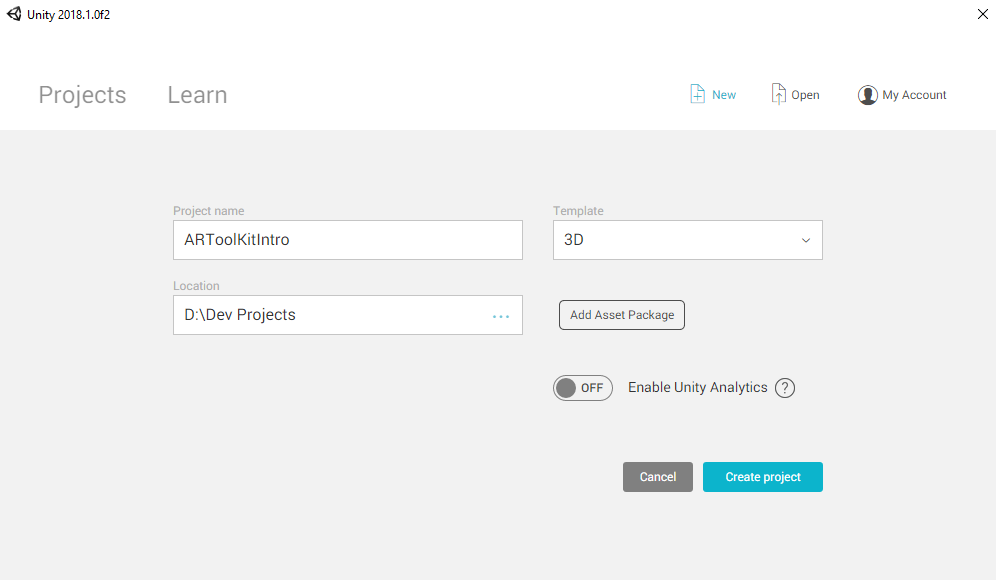
- Now, we need to import the Unity Package into Unity. This is pretty straightforward. Right-click the Assets folder, highlight Import Package, and select Custom Package:
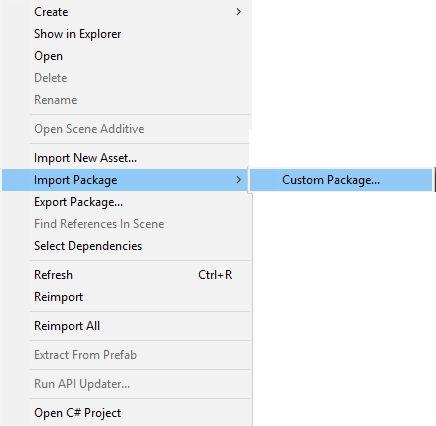
- Navigate to the folder that houses the downloaded Unity Package, click on it, and select Open. You should see a dialog box with checkboxes inside. Click on All and then click on Import:
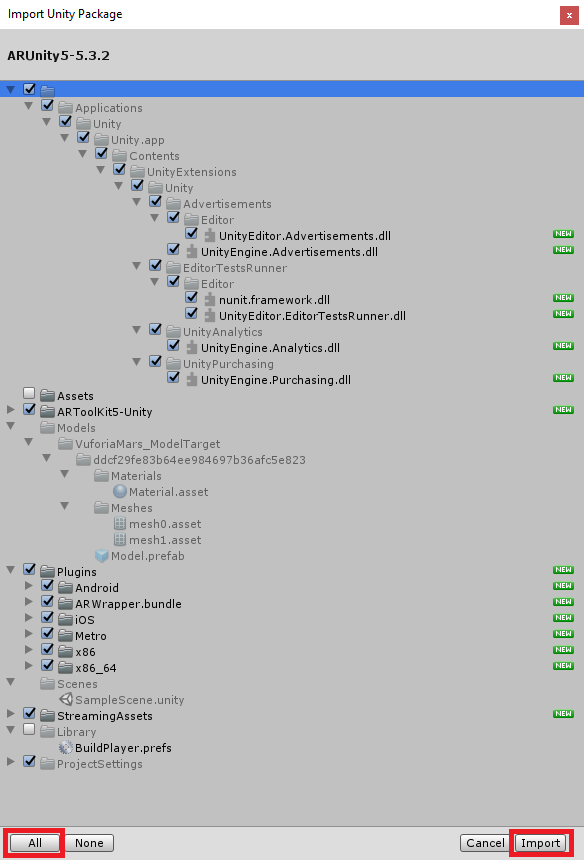
- You will see three folders after the import is complete (ARToolKit5-Unity, Plugins, and StreamingAssets):

Inside the ARToolKit5-Unity folder, there are the Example Scenes, Examples, Materials, Resources, Scripts, Changelog, and Readme files and folders:
- Inside Scripts, we have an Editor folder with the features shown in the following screenshot:

- Inside the Editor folder, we have the following:

- Next up is the Plugins folder. It has folders listed as follows:
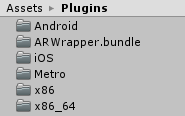
- If you look at the menu bar at the top of the Unity Editor, you will see an additional toolbar item: ARToolKit. The drop-down menu shows several options: ARToolKit for Unity Version 5.3.2, Download Tools, Build, Support, and Source Code:
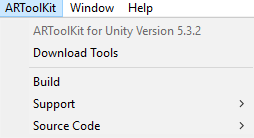
- Support has Home Page, Documentation, and Community Forums:
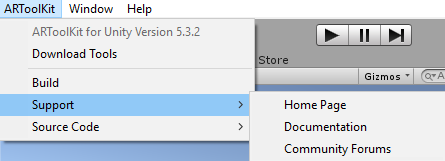
- Source Code has View ARToolKit Source and View Unity Plugin Source:
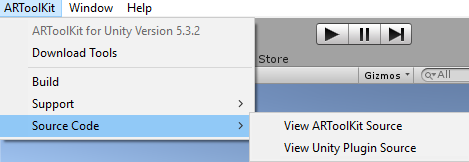
The basics are out of the way, so we can begin building our "Hello World" with ARToolKit:
- The first thing we need to do is create an empty game object in the Hierarchy pane and rename it ARToolKit.
- The next step is to add the ARController script to the game object and delete the Camera:

- The ARController script handles the creation and management of AR tracking. It automatically adds a camera at runtime and is controlled by the user layers that we provide.
- With this latest version of ARToolKit, the basic user layers are provided for you already: AR background, AR background 2, and AR foreground for User Layer 8, User Layer 9, and User Layer 10, respectively:
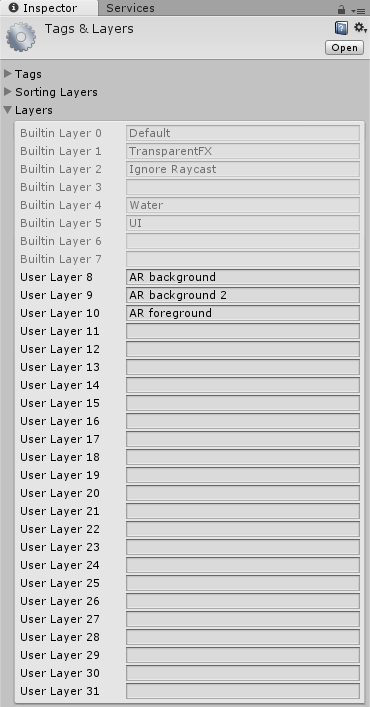
- The AR Controller script has a Video Options drop-down menu:
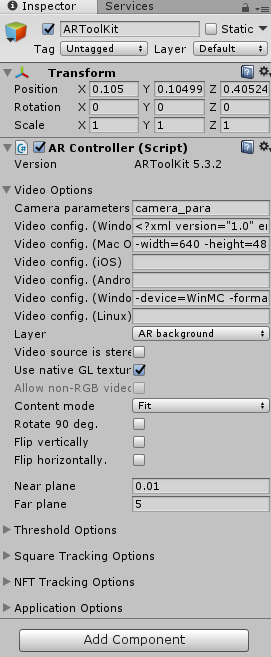
- Since we have so many different options for video, we need to set it up properly:
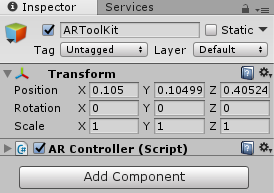
- If you get errors in the console of the Unity Editor, then you don't have the latest version of ARToolKit with the version of Unity we are using in this book.
Since I am building for Windows, I will go to the first option of Video config and input the following:
<?xml version="1.0" encoding="utf-8"?>
<dsvl_input>
<camera show_format_dialog="false" frame_width="1280" frame_height="720" frame_rate="29.97">
<pixel_format>
<RGB32 flip_v="true"/>
</pixel_format>
</camera>
</dsvl_input>
Now, since my computer does not presently have a webcam attached to it, I get an in-game error message, but the code compiles and runs as expected. If you have a webcam attached and it is recognized appropriately, you should have a direct feed from your webcam.
This concludes the Hello World for ARToolKit; we will be revisiting this one later on for more in-depth and fun usage of this SDK.
Setting up ARCore
ARCore and ARKit are fundamentally very similar, but you can't compile ARKit on a Windows environment, which is what I'm presently using. Not to worry; when we get to ARKit, I will be using a macOS to give you a proper view and feel of how things are when using it.
That being said, it is now time to take a deeper look at ARCore.
ARCore was made by Google and is currently in the early preview stages; it hasn't even reached release 1.0 yet, so there are bound to be many changes, some of which could be extremely damaging to existing apps or games.
There are two ways to get the SDK preview for Unity. The first is through a Unity Package file (https://developers.google.com/ar/develop/unity/quickstart-android) and the other is through GitHub (https://github.com/google-ar/arcore-unity-sdk). Now, since I have been having an issue with downloading from Amazon Web Services lately, I will use the second link:
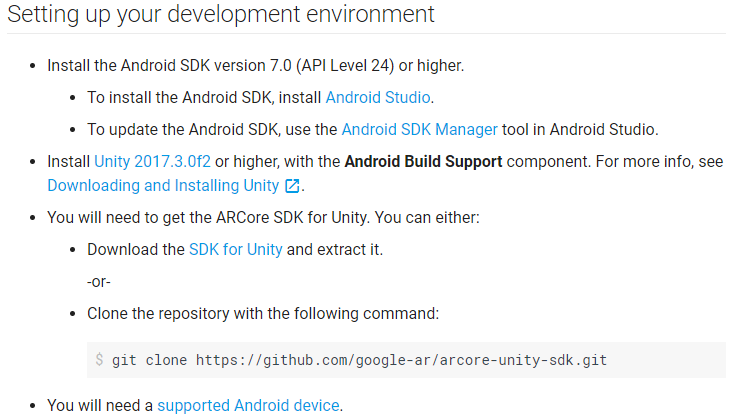
It is key to remember that, if you don't have a Samsung Galaxy 8 or a Google Pixel phone, you will not be able to run proper tests on your device. However, if you also install Android Studio, you do get access to the Android Emulator:
- To begin, create a new project in Unity and call it ARCoreTutorial:
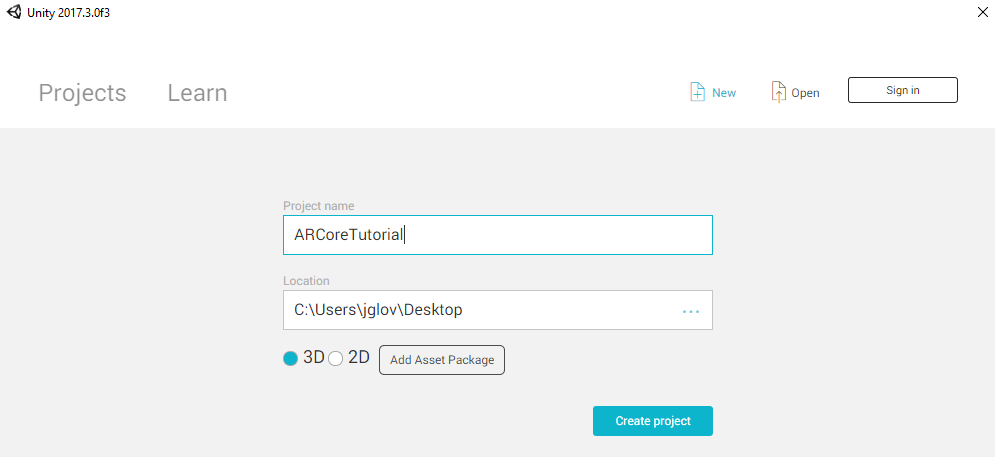
- We need to change the Build Settings to Android before doing anything else:
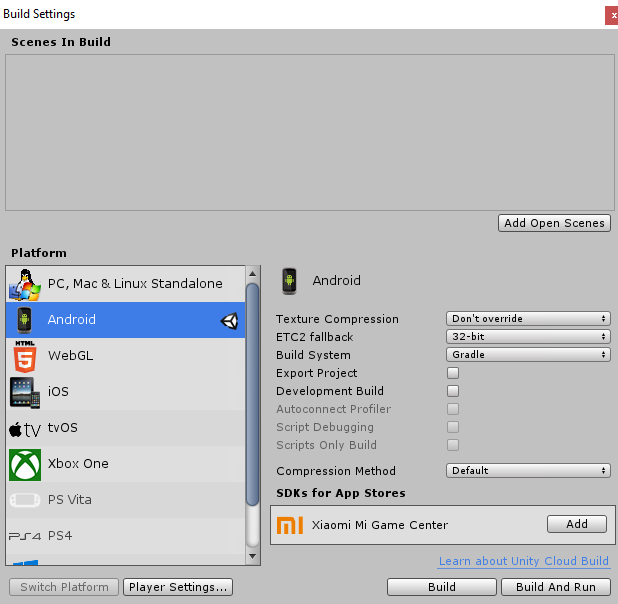
- Next up, we need to change the Player Settings. The main settings we need to change are within the Other Settings tab, so let's take a look at what needs to be changed.
- Other Settings: We want Multithreaded Rendering unchecked; Minimum API Level should be Android 7.0 ‘Nougat' API level 24; and Target API Level should be Android 7.0 ‘Nougat' API level 24 or Android 7.1 ‘Nougat' API level 25:
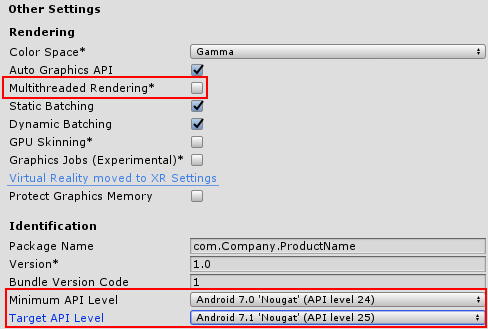
5. XR Settings: We want ARCore Supported to be checked:

6. Next up, we want to unzip the SDK or import the package into Unity3D:
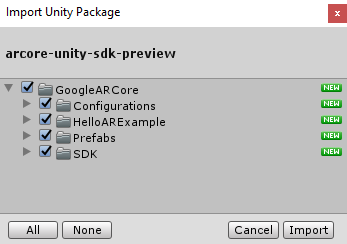
Right away, we should see a DLLNotFoundException for tango_client_api2. This is normal and is well-known by the community. It should not cause any errors at runtime, though; it should be fixed in a later release.
Setting up ARKit
ARKit requires the usage of macOS High Sierra, because of the XCode 9 and above requirement for compiling and making changes to the API itself. So, I would highly suggest having a macOS from late 2011 or newer. I am utilizing a Mac Mini 2011 model with 8 GB of RAM, although the standard 4 GB should be plenty. Unity3D does utilize OpenCL/OpenGL extensively, which requires a GFX card capable of utilizing Metal. 2011 and earlier macOSs do not have this ability natively; this could be circumvented by having an external GPU (Radeon RX 480 is currently the only GPU supported officially for this).
With that out of the way, we can begin with installing and configuring ARKit for Unity3D on our macOS.
There are a couple of ways you can install ARKit:
- We can navigate to the plugin page on the Asset Store (https://www.assetstore.unity3d.com/en/#!/content/92515):
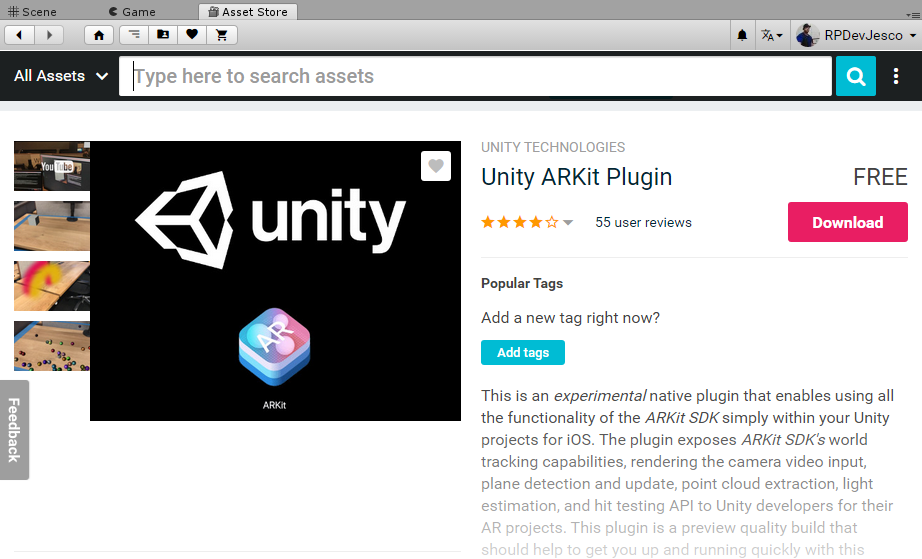
- Or we can download the plugin directly from the Bitbucket repository (https://bitbucket.org/Unity-Technologies/unity-arkit-plugin/overview):

- If we go the first route and install from the Asset Store, we don't have to worry about copying the files into our project ourselves, but either way it is simple enough to do, so take your pick on the method you want to go with and create a new project called ARKitTutorial:
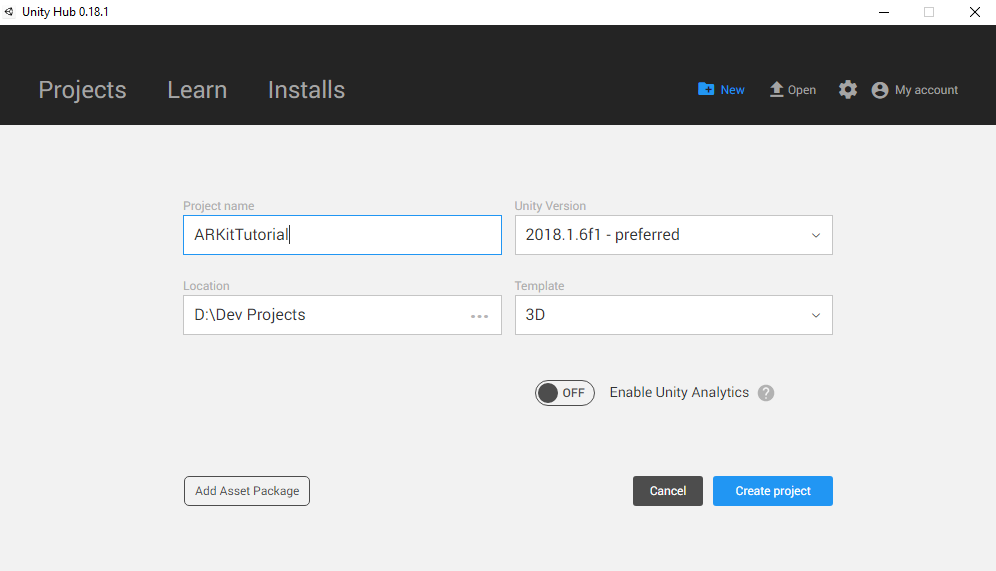
Next up, we have quite a bit to unpack regarding what is actually in this package:
- /Assets/Plugins/iOs/UnityARKit/NativeInterface/ARsessionNative.mm – This is the Objective-C code that is the actual interfaces with the ARKit SDK.
- /Assets/Plugins/iOS/UnityARKit/NativeInterface/UnityARSessionNativeInterface.cs – This is the scripting API that glues the native code to ARKit.
- /Assets/Plugins/iOS/UnityARKit/NativeInterface/AR*.cs – These are the equivalents of the data structures exposed by ARKit.
- /Assets/Plugins/iOS/UnityARKit/Utility/UnityARAnchorManager.cs – This is a utility script that tracks the anchor updates from ARKit and can create the proper corresponding GameObjects in Unity for them.
- /Assets/Plugins/iOS/UnityARKit/Editor/UnityARBuildPostprocessor.cs – This is an editor script that runs at build time on iOS.
- /Assets/Plugins/iOS/UnityARKit/UnityARCameraManager.cs – This is the component that should be placed on a GameObject in the scene that references the camera that you want to control. It will position and rotate the camera as well as provide the correct projection matrix based on updates from ARKit. This component also initializes as ARKit Session.
- /Assets/Plugins/iOS/UnityARKit/UnityARVideo.cs – This is the component that should be placed on the camera and grabs the textures needed for rendering the video. It sets the material needed for blitting to the backbuffer and sets up the command buffer for blitting.
- /Assets/Plugins/iOS/UnityARKit/UnityARUserAnchorComponent.cs – This is the component that adds and removes Anchors from ARKit based on the life cycle of the GameObject it is added to.
Before we build our own "Hello World" example, we should build the UnityARKitScene.unity to iOS to get a taste of what ARKit is capable of, as it demonstrates all of the basic functionality of ARKit in that scene.
UnityARKitScene is included in the plugin as well as a couple of other example projects. We will compile the UnityARKitScene as our Hello World application.
However, before we do that, we need to talk about the file structure, because those who are not well-versed with compiling to iOS will have some serious issues compiling without further clarification. You may have noticed quite a few items that we have not mentioned that are in the plugin, so let's go ahead and discuss what all of them do before moving on.
\UnityARKitPlugin main directory files:
- ARKitRemote – Allows you to send remote commands from your device to the Unity3D editor
- Examples – This directory houses example scripts and scenes to showcase various things you can do with ARKit and this plugin
- Plugins – Houses the directories required to run ARKit
- Resources – Houses the resource files required for ARKit
Plugins\iOS\UnityARKit\NativeInterface cs files:
- ARAnchor – Anchors an object to a location in the world from the camera feed.
- ARCamera – Tracks the camera's position.
- ARErrorCode – Error codes.
- ARFaceAnchor – Face tracking anchor.
- ARFrame – Returns data about the camera, anchors, and light estimates.
- ARHitTestResult –Returns any collision results.
- ARHitTestResultType – Enumeration for the hit test types available.
- ARLightEstimate – Calculates how much luminosity is in the image or video.
- ARPlaneAnchor – Anchors a plane to a specific 4x4 matrix.
- ARPlaneAnchorAlignment – Aligns the anchor horizontally with respect to gravity.
- ARPoint – A point struct for x and y values as a double.
- ARRect – A struct that takes ARPoint as the origin and ARSize as the size.
- ARSessionNative – Native plugin used to specify framework dependencies and the platforms the plugin should work for.
- ARSize –A struct that takes a width and height value as a double.
- ARTextureHandles – A native Metal texture handler for the camera buffer which takes an IntPtr (int pointer) for both textureY and textureCbCr values.
- ARTrackingQuality – Enumeration for tracking qualities available.
- ARTrackingState –Enumeration for tracking states. Limited, Normal, and NoAvailable are the options.
- ARTrackingStateReason – Enumeration for the state reasons. Options are Excessive Motion, Insufficient Features, and Initializing.
- ARUserAnchor – Defines this anchor's transformation matrix for rotation, translation, and scale in world coordinates.
- UnityARSessionNativeInterface – Native plugin wrapper code.
\Plugins\iOS\UnityARKit\Helpers cs files:
- AR3DOFCameraManager – A helper class for 3D objects with the AR Camera
- ARPlaneAnchorGameObject – A class that attaches a GameObject with the ARPlaneAnchor
- DontDestroyOnLoad – Makes sure the GameObject doesn't get destroyed on load
- PointCloudParticleExample – Creates a point cloud particle system
- UnityARAmbient – A helper function for ambient lighting
- UnityARAnchorManager – A manager for ARPlaneAnchorGameObjects
- UnityARCameraManager – A helper class for the ARCamera
- UnityARCameraNearFar – Sets the Near Far distance of the camera appropriately
- UnityARGeneratePlane – Creates an ARPlaneAnchorGameObject
- UnityARHitTestExample – Tests collisions with various amounts of planes, from few to infinite
- UnityARKitControl – A helper class designed for creating a test ARSession
- UnityARKitLightManager – A helper class for managing the various lighting possibilities
- UnityARMatrixOps – A class for converting a 4x4 matrix to Euclidean space for quaternion rotation
- UnityARUserAnchorComponent – A helper class for creating Anchor added and removed events
- UnityARUtility – A helper class to do coordinate conversions from ARKit to Unity
- UnityARVideo – A helper function to render the video texture to the scene
- UnityPointCloudExamples – A helper function to draw a point cloud using particle effects
\Plugins\iOS\UnityARKit\Shaders shader files:
- YUVShader – A gamma Unlit Shader for rendering Textures
- YUVShaderLinear – A linear Unlit Shader for rendering Textures
\UnityARKitPlugin\Resources file:
- UnityARKitPluginSettings.cs – Is a scriptable object that toggles whether ARKit is required for the app and toggles Facetracking for the iPhone X.
UnityARKitPlugin\ARKitRemote files:
- ARKitRemote.txt – A text file that explains how to set up and use ARKitRemote
- EditorTestScene.unity – Test scene that should run when running ARKitRemote
- UnityARKitRemote.unity – Scene that should be compiled and installed on an applicable device
- ARKitRemoteConnection.cs – Used to send data from the device to the UnityEditor
- ConnectionMessageIds – GUIDs for the Editor Session Message
- ConnectToEditor.cs – Creates a network connection between the editor and the device
- EditorHitTest – Returns collision data from device to editor
- ObjectSerializationExtension.cs – An extension to convert an object to a byte array
- SerializableObjects.cs – Serializes Vector 4 data and a 4x4 matrix
- UnityRemoteVideo.cs – Connects to the editor and transfers a video feed from the device to the editor
UnityARKitPlugin\Examples files:
- AddRemoveAnchorExample – An example program to add and remove anchors
- Common – Has common materials, models, prefabs, shaders, and textures that are used in various projects
- FaceTracking – Face tracking example application
- FocusSquare – An example scene where it finds a specific anchor
- UnityARBallz – An example scene where you play a game with balls
- UnityARKitScene – A basic scene with minimal scripts attached to test if ARKit works appropriately
- UnityAROcclusion – An example project that showcases various lighting conditions
- UnityARShadows – An example project that handles low lighting conditions
- UnityParticlePainter – An example project that lets you paint with particles
Now that we have a fundamental understanding of everything inside this package, let's build our Hello World with ARKit.
Building Hello World in ARKit
The first thing we need to do after we open the UnityARKitScene is to set up the build settings:
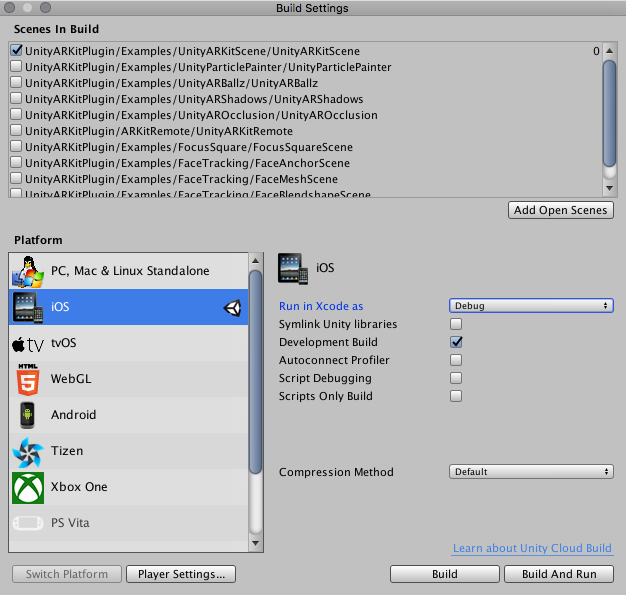
- Click on Build Settings and select Player Settings.
- We want to scroll down to Identification. The Bundle Identifier should be set to com.unity.ARKitHelloTutorial, Version to 0.1, and Build to 10.1. The Automatically Sign checkbox should be checked. Leave the Automatic Signing Team ID settings blank:
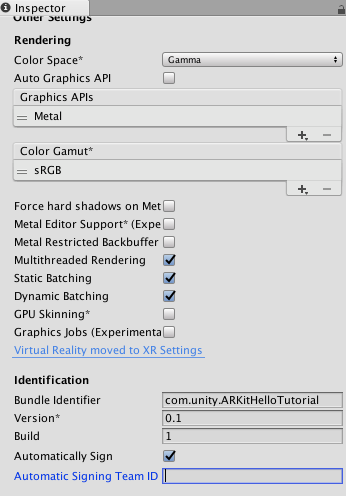
- Build the UnityARKitScene for iOS only. Run Xcode in Debug mode.
- Only the Development Build checkbox should be checked; everything else should be left as default.
- Click Build. I will save the file as iOSTest in my data drive within a folder called iOS:
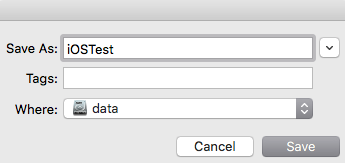
- Building should not take very long at all, perhaps around two minutes for a first build.
- The next thing we want to do is open the folder we saved the project in and open the .xcodeproj file in Xcode:
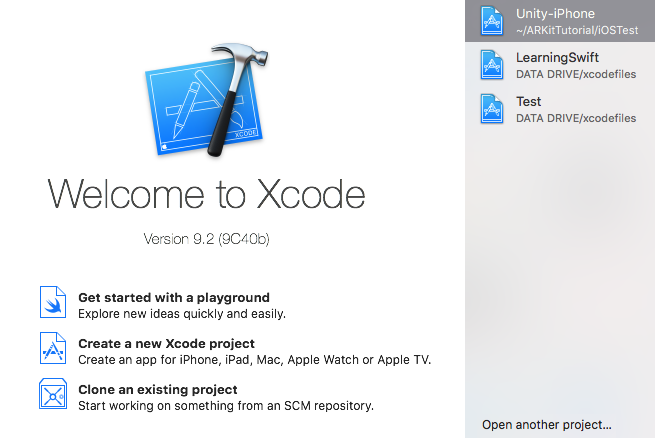
- Let's take a look at the Base project you will see in Xcode:

- The first thing we want to check is the Identity tab to make sure that these settings are the same as in Unity3D:
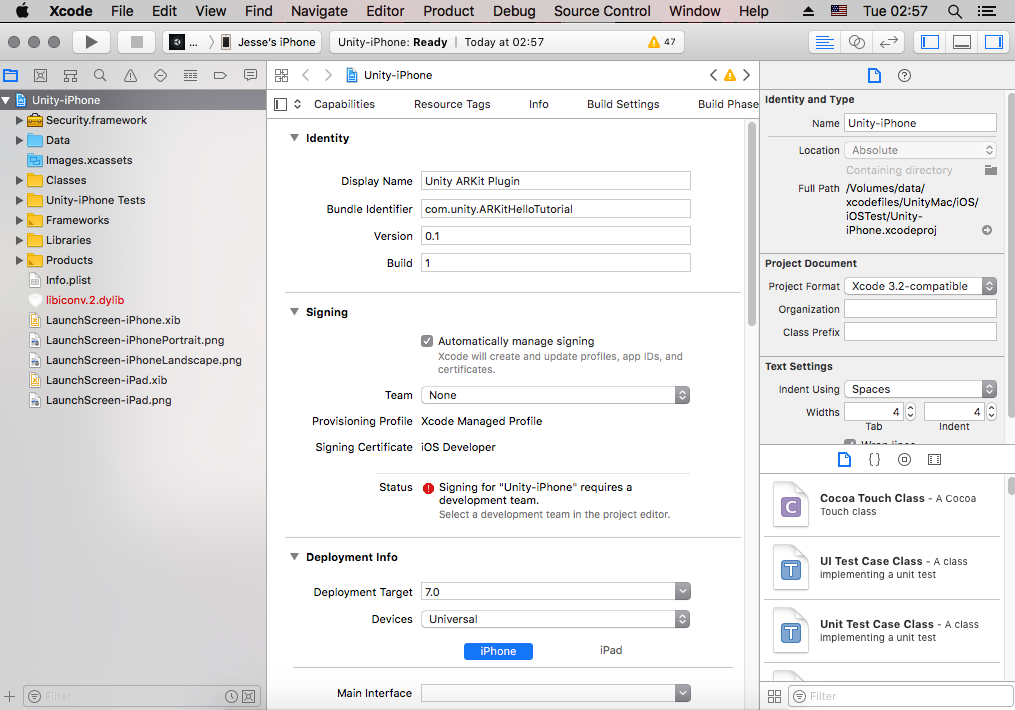
- Now, we need to look at the Signing subsection:
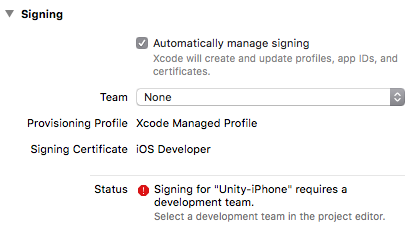
- We need to make sure to add our Personal Team name to it, which you can get by signing in to your Apple Developer account and clicking on the arrow for the team you want to use:
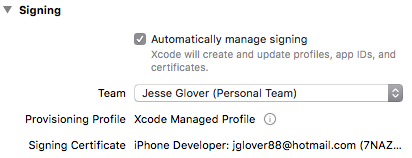
- Deployment Info is next. The Deployment Target needs to be changed to 11.2. Devices should be set to iPhone only. The Main Interface is LaunchScreen-iPhone.xib:
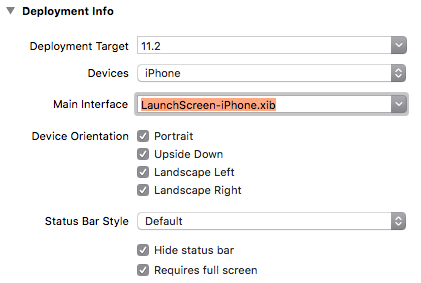
- Click on Build Settings at the top, as there are a few settings we need to change here as well.
- In Architectures, ARCHS for iPhone should be set to Standard. SDKROOT should be Latest iOS (iOS 11.2). SUPPORTED_PLATFORMS should be iOS:

- Next up, scroll down to look at signing, and the values should be already set to the correct ones:
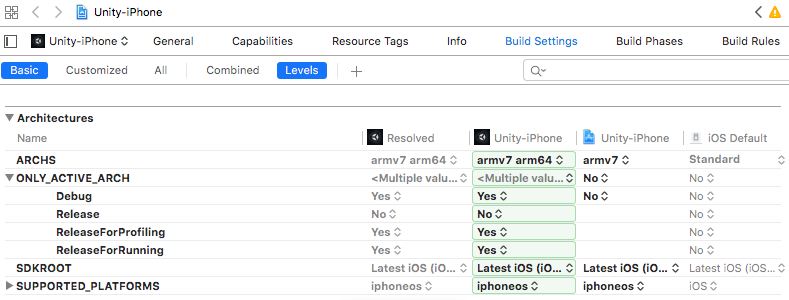
- Now, click on Product and Build:
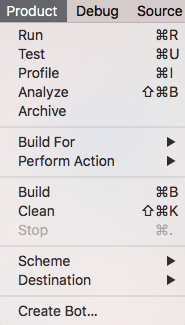
- The build should have completed successfully with roughly 47 warnings, which is normal:

- Now, we can build and test in the simulator. What we want to do is change from the iPhone to one of the simulators in the list, so click on the device list next to your iPhone or whatever device you have:

- You will see a big list of devices you want to use. This will range from simulations of devices to the iOS device you have connected to your macOS:
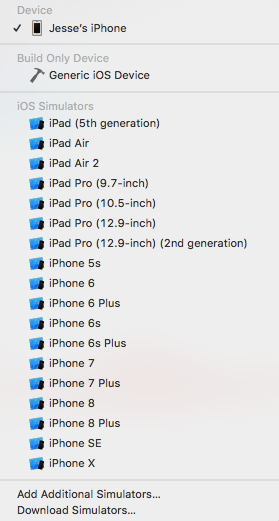
- Click on the simulation you want to use, and then build and run the application.
Congratulations! We have completed this Hello World application.






























































